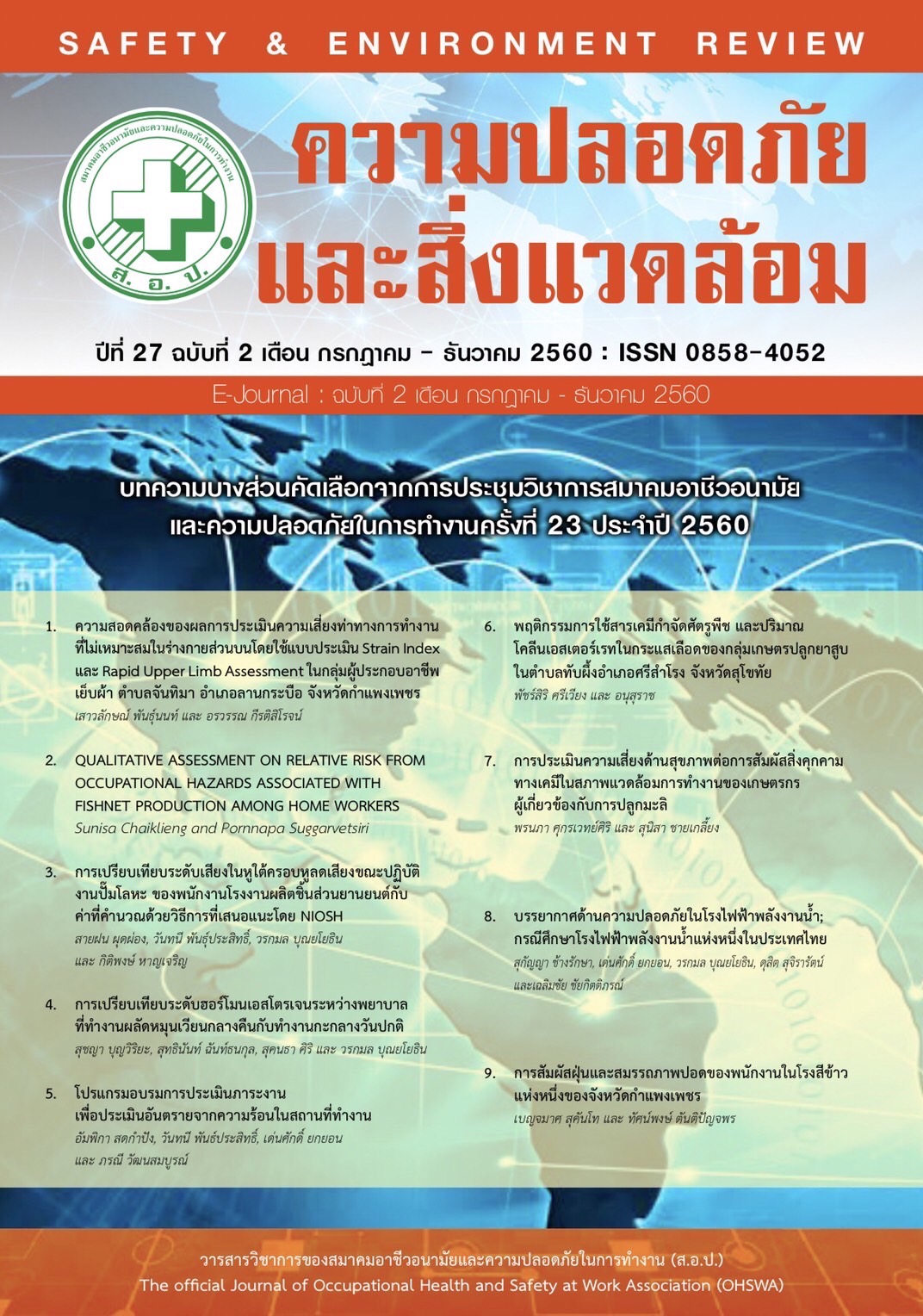THE COMPARISON OF THE NOISE REDUCTION LEVEL IN THE EARS WHEN USING EARMUFFS DURING METAL STAMPING WORKING AMONG AUTO PARTS MANUFACTURING WORKERS WITH CALCULATION VALUE USING NIOSH’S RECOMMENDATION METHOD
Keywords:
Ear muffs, Noise exposure, Noise Reduction RatingAbstract
The NRR specified by manufacturers on the label of devices should be considered for selecting a hearing protection device to reduce Effective A-weighted sound pressure level: (L’AX) .The purposes of this study were aimed to compare to measure the noise level inside the ears while wearing hearing protection devices with the calculation (L’AX) of by using NIOSH’s recommendation formula. This study is cross sectional study. Study in an Automotive Parts Manufacturing Company. The data of this study were collected by measuring the noise levels inside the ears of workers while they were wearing an ear muffs, by using a sound level meter. The test process utilizes two sound level meters with microphones positioned with one inside the ears while wearing an ear muffs and the other outside the subjects’ ears. The sound level measured inside the ears are ENLs obtained from measurements and the calculated ENLs were obtained from calculation of noise levels outside the ears and the NRR. The results show that measured ENLs were significantly less than the calculated ENLs using NIOSH’s recommendation formula (P<0.001). The average measured attenuation of the muffs were 16.57, 19.68, 20.21 and 22.45 dBA respectively. This was better than that of the calculated NRR, using NIOSH’s recommendation formula, which was 8.75, 11.75, 13.25 and 15.5 dBA respectively.
References
กระทรวงแรงงาน. มาตรฐานการวินิจฉัยโรคจากการทำงาน ฉบับเฉลิมพระเกียรติ เนื่องในโอกาสมหามงคลเฉลิมพระชนมพรรษา 80 พรรษา 5 ธันวาคม 2550. เข้าถึงได้จาก: http://www.summacheeva.org/documents/share_56_diag.pdf, เข้าถึงเมื่อ 15 เมษายน 2559
กระทรวงแรงงาน. กำหนดมาตรฐานในการบริหารจัดการ และดำเนินการด้านความปลอดภัย อาชีวอนามัย และสภาพแวดล้อมในการทำงานเกี่ยวกับความร้อน แสงสว่าง และเสียง พ.ศ. 2549. ในกฎกระทรวงแรงงาน. กระทรวงแรงงาน. 2549.
กระทรวงอุตสาหกรรม. กำหนดมาตรฐานผลิตภัณฑ์อุตสาหกรรม ข้อแนะนำในการเลือก การใช้ การดูแล และการบำรุงรักษาอุปกรณ์คุ้มครองความปลอดภัยส่วนบุคคล เล่ม 1 อุปกรณ์ปกป้องการได้ยิน. ในประกาศกระทรวงอุตสาหกรรม ฉบับที่ 4456. กระทรวงอุตสาหกรรม. 2555. เข้าถึงได้จาก: http://www.ratchakitcha.soc.go.th/DATA/PDF/2555/E/185/4.PDF, เข้าถึงเมื่อ 16 เมษายน 2559
Berger E. H. E•A•RLOG16 A New Hearing Protection Attenuation Standard - ANSI S12.6. [cited on 2015 July 16]. Available from: http://aearo.com/pdf/hearingcons/earlog16.pdf
รศ.ดร.วันทนี พันธุ์ประสิทธิ์. สุขศาสตร์อุตสาหกรรม กลยุทธ์ประเมิน ควบคุม และจัดการ. มหาวิทยาลัยมหิดล. 2557.
Berger E. H. HPD Labeling: EPA Rulemaking and an Updated ANSI S12.42.เข้าถึงได้จากhttp://c.ymcdn.com/sites/www.hearingconservation.org/resource/resmgr/imported/S6%20-%20Berger%20T09-22%20NHCA%20-%20EPA%20%26%20S12.42.ppt, เข้าถึงเมื่อ 16 กรกฎาคม 2559
National Institute for Occupational Safety and Health. Method for Calculating and Using the Noise Reduction Rating–NRR. [cited on 2015 May 15]. Available from: http://www.cdc.gov/niosh/z-draft -under-review-donot-cite/hpdcompdev/pdfs
Pedro M Arezes & Joel Geraldes. Assessing Differences in Methodologies for Effective Noise Exposure Calculation. International Journal of Occupational Safety and Ergonomics (JOSE) Vol.15, No.2 183-191. 2009.
วุฒิชัย สรรพวุธ.การศึกษาเปรียบเทียบระดับเสียงในหูเมื่อ สวมใส่ปลั๊กอุดหูลดเสียงจากการตรวจวัดและคำนวณด้วยสูตรที่เสนอแนะโดย NIOSH. 2557
John R. Franks, William J. Murphy , Jennifer L. Johnson, and Dave A. Harris. Four Earplugs in Search of a Rating System. Ear & Hearing 2000.
Ewa Kotabinska. Measurement of Effective Noise Exposure of Worker Wearing Ear-Muffs. International Journal of Occupational Safety and Ergonomic. Volume 15.No.2, 193-2.2009
Downloads
Published
Issue
Section
License

This work is licensed under a Creative Commons Attribution-NonCommercial-NoDerivatives 4.0 International License.
This article is published under a Creative Commons Attribution-NonCommercial-NoDerivatives 4.0 International License (CC BY-NC-ND 4.0), which allows others to share the article with proper attribution to the authors and prohibits commercial use or modification. For any other reuse or republication, permission from the journal and the authors is required.



